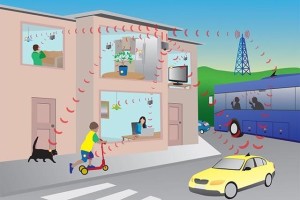 Don’t feel bad if you don’t really know anything about 5G wireless networking – because, by most standards, it doesn’t actually exist yet.
Don’t feel bad if you don’t really know anything about 5G wireless networking – because, by most standards, it doesn’t actually exist yet.
The cross-pollination of codified specifications, new products, and technological innovation required hasn’t yet brought 5G to fruition.
What there has been, however, is a lot of hype. Samsung grabbed attention in May with its announcement of a 1Gbps wireless connection it referred to as “5G,” saying it would bring the capability to its production smartphones by 2020.
The European Commission’s Horizon 2020 plan, announced this month, includes roughly $172 million for 5G research and development, and South Korea’s Yonhap News announced that country’s government would spend $475 million on developing a national 5G network, to be completed by 2020. Both proposals cite the transformative effects and massive economic benefits of 5G technology.
The problem, however, is that no one seems to agree on precisely what the term 5G even means. Sathya Atreyam, a research manager at IDC, says that it’s become a buzzword at this point.
“There are many players right now who are claiming that they are investing a lot of money in 5G research, [but] they’re all investing in different areas of 5G … somebody’s focused on increasing data speeds, somebody’s focused on better coverage,” he says.
“It reminds me of a story which is often heard,” Atreyam adds. “There are six blind men touching an elephant and giving their definition of it. Every one is true, but it’s only part of the puzzle.”
Standards bodies like the International Telecommunication Union, the Institute of Electrical and Electronics Engineers, and the 3rd Generation Partnership Project are all tracking the various technological developments. The ITU officially recognised the IMT-Advanced standard in January 2012, though it did not use the term 5G in describing the technologies, which include the next generations of the successful LTE and the less-successful WiMAX.
It’s important to remember, of course, that even when a particular ‘G’ term is fairly stable and commonly understood – 3G, for example, is generally agreed to refer to the ITU’s IMT-2000 standard – it isn’t a hard-and-fast official definition. Refinements in WCDMA technology produced HSPA and HSPA+, which are often referred to as “3.5G” or “3.75G,” without fundamentally changing the underlying hardware.
Indeed, those technologies were even more ambitiously titled in the recent past, according to Forrester principal analyst Frank Gillett.
“With 4G, we saw versions of 3G – HSPA+ – called 4G, and then we had to say LTE to mean true 4G,” he says. “I’m expecting to see a lot of silly marketing junk later in the decade, as the 5G stuff ramps up.”
So what might 5G technology actually look like? That’s not known for sure, but experts like Craig Mathias, a well-known wireless consultant and Network World blogger, think there are clues out there.
He says that the key factor in 5G and other future developments is limited spectrum availability.
Wireless communication works best between 600MHz and 3GHz. At frequencies lower than 600MHz, the waves are too large, and the size of receiving antennas becomes “problematic,” he says, citing older VHF portable TVs with long, telescoping antennas. Above 3GHz, signals begin to dissipate quickly and become more directional, resulting in shorter effective range.
What this means is that we’ll have to get creative with the spectrum available to us, Mathias says. One way this will happen in the future is the use of small cells, which do not provide as much geographical coverage as larger ones. If this sounds counter-intuitive, think of it as painting with a fine brush – at any given frequency, an area could either be monopolised by a single large cell, or served by a dozen smaller ones.
“That’s really what we want to do – we’re not getting any more spectrum, but we can re-use the spectrum – in other words, make multiple use of it simultaneously – given the geographic distance between the various cells,” says Mathias.
In addition to a shortage of spectrum, he says, there’s a limit to how much data can be stuffed into a particular block of it at any given time, a concept called spectral efficiency. Work-arounds like MIMO – which uses multiple antennas and receivers to service a single stream of data – have managed to dramatically increase spectral efficiency, to what Mathias considers a surprising degree.
“It sounds like absolute magic, and it really shouldn’t work, but the denser you make a particular MIMO system … the greater the spectral efficiency,” he says.
Whatever the nature of the eventual 5G technology, IDC’s Atreyam says that a couple of capabilities will be essential. It’s not just a speed boost, although that will obviously happen, as well.
Automation could be one of the central features of 5G, for the sake of both end-user functionality and the health of the network itself. Built-in intelligence could be used to provide location-aware services – turning on a home’s climate control when the owner is detected leaving work in the evening, routing phone calls to different devices, depending on which is close by – as well as self-configuration for maximum performance and reliability.
“You need a network which can handle tons of, as we call it, signalling information, because the network needs to know how to reach you, and how to get the information that you need … so there’s a lot of underlying messaging which happens in the background,” says Atreyam.
Gillett says this new degree of flexibility ought to be an important part of 5G, offering a number of handy features.
“There’s a lot of crazy things that you can do, like change … frequencies in the middle of a transmission,” he says, also citing the ability to use variable amounts of bandwidth, as needed for demand.
One of the few things that is clear about 5G is that we won’t see it in the marketplace for some little time – most sources agree that the 2025 time frame for 5G-enabled goodies at retail is the best guess.
What’s more, there also seems to be general agreement on the broad strokes of what 5G should accomplish – the European Telecommunications Standards Institution recently hosted European Commission principal scientific officer Mário Campolargo at the future mobile summit in France. In a keynote, Campolargo outlined some of the same issues raised by Atreyam and Mathias, including spectrum limitations and the challenges posed by the so-called “Internet of things.”
And just a month before that, Ericsson CTO Vish Nandlall said much the same thing at GigaOm’s Mobilize conference in San Francisco. The flexibility and intelligence in 5G, he said, should be similar to cloud computing.
“[Different applications] will actually get different slices of the network with different technologies,” Nandlall said.
So the good news, for businesses, is that the technology isn’t something that will have to be dealt with tomorrow. What’s more, according to Gillett, the future looks promising.
“For businesses, I think, ultimately, this is about lowering the cost of communication, making [it] more reliable and ubiquitous, and less having to think about it,” he says. “Frankly, from the point of view of an end-user, why should you have to think about switching from the wide area network to the local network?”
But despite the hints at the shape of the technology to come, and broad agreement about what, exactly, 5G ought to be able to do, concrete details are thin on the ground. A great deal can change between now and then.
“It’s still pretty early to be speculating on, say, new use cases or new behaviours that might become possible,” Gillett says. “And when you start thinking 2020, you start to wonder, are phones going to be earrings? Is it going to be an implant? … a spray-on tattoo that I wash off once a week?”
Only time, it seems, will tell.





